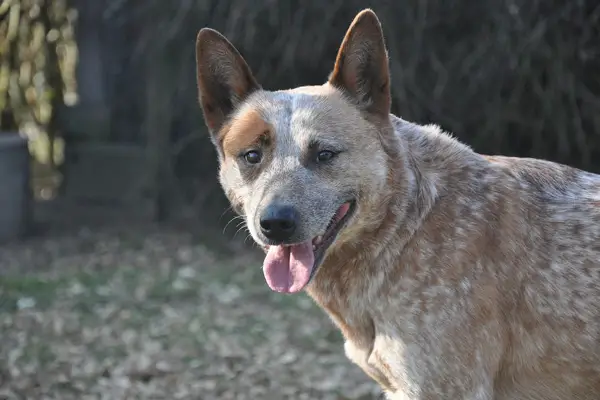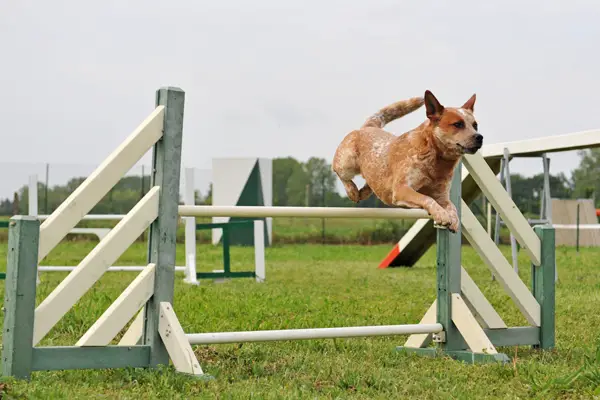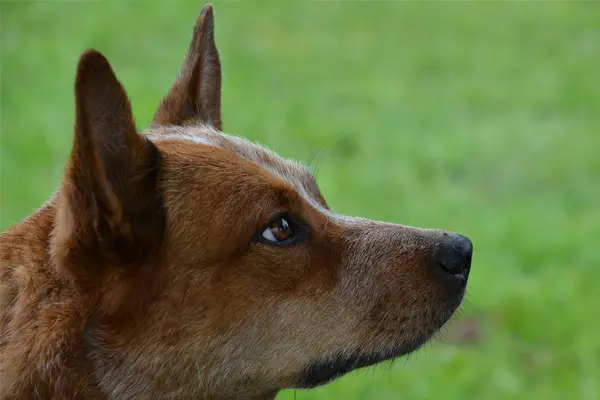Australian Cattle Dogs are medium-sized dogs known for their herding skills. They have a sturdy and muscular body covered by a short coat that comes in blue-gray or red colors. The Australian Cattle Dog is known to have boundless energy and can work all day.
This dog breed is not a couch potato, and they will not be the right dog for anyone. But with the right owner, he can be the sweetest companion. He is also known as a Velcro dog because he couldn’t stop attaching himself with their humans.

Australian Cattle Dog Statistics
| Dog Breed Group | Herding |
| Breed Size | Medium |
| Height | 18-20 inches (male); 17-19 inches (female) |
| Weight | 35-50 pounds |
| Lifespan | 12-16 years |
Australian Cattle Dog Ratings
| Energy level | |
| Exercise needs | |
| Requires attention | |
| Playfulness | |
| Trainability | |
| Shedding | |
| Grooming | |
| Friendly with family | |
| Friendly with kids | |
| Friendly with strangers | |
| Friendly with other dogs | |
| Prey Drive |
History
The Australian Cattle Dogs, as their name implies, were bred in Australia in the 19th century. They were developed by Australian settlers to assist with the herding of cattle on large ranches. As the beef industry expanded, so was the need for the dogs.
The dog breed was developed by crossing several dog breeds. But it was only the native Dingo that was listed on the records. It was believed that the breed was chosen in consideration that the dog should be able to survive Australia’s harsh weather conditions.
Blue-colored Australian Cattle Dogs are the most popular among the ranch owners, particularly in Queensland. And in 1893, Robert Kaleski started breeding these Blue Australian Cattle Dogs, known as Blue Heelers at that time.
By 1897, Kaleski started showing the dog and even drew up a standard of the dog breed. By 1903, the standard was approved in The Kennel Club of New South Wales. From being known as the Australian Heeler, the dog breed was renamed Australian Cattle Dog.
It was only in May 1980 that the dog breed was officially registered under the American Kennel Club. And now, he is one of the most popular dog breeds in the US.
They are still used in herding cattle in some areas of Australia. And some people still refer to them as Blue Heelers or Queensland Heelers.

Temperament
The American Kennel Club describes the Australian Cattle Dogs as alert, curious, and pleasant. They are incredibly active and require consistent mental and physical activity. These dogs will not be great companions for those who can’t provide their needs as they can be very destructive when bored.
This dog needs to be kept busy until he’s tired. A tired Australian Cattle Dog is a good dog.
With the right owner, these dogs can be the most affectionate pets. They are also known as Velcro dogs, meaning they would love to stay as close to their humans as possible. They are also loyal and will stand to protect.
They may not be great for owners with little children. Due to their herding instincts, they tend to chase anything or anyone small and moving. Worst, they might even end up biting.
They’re best in one-dog households as they tend to be aggressive with other dogs. They are also wary with strangers and will be ready to fight if he detects danger.
Training Australian Cattle Dogs can be a challenge. They are hard-headed dogs and very clever, that’s why it would require a lot of patience to handle them. Be consistent and firm, but never act with harshness.
Early socialization will ensure that he will grow up to be a well-rounded dog. This will also help him control his behavior towards strangers, children, and other pets.
Australian Cattle Dog Care Requirements
- Nutrition: As highly active dogs, the Australian Cattle Dog needs high-quality food to supply his activity needs. It must also contain all the essential nutrients. They’ll also do fine regardless if you’ll feed him home-cooked or raw food diet as long as it’s complete with what he needs. If you are serving him with commercial food, make sure it contains animal-based protein rather than plant-based. Avoid those that contain artificial flavorings, coloring, and fillers. Home-cooked foods should contain at least 50% of animal protein from high-quality meat such as chicken, fish, or beef. Add 25% of carbohydrates that you can get from sweet potatoes and brown rice. You can finish it up with 25% of vegetables and fruits for some fiber and vitamin sources. For a raw food diet, you can ask your veterinarian for a food guide on how to feed your Australian Cattle Dog properly. You can also add some cooked carbohydrates.
- Grooming: Australian Cattle Dogs have a smooth double-layer coat that sheds regularly. This is why daily brushing is also needed. You don’t want all those hairs around your house and furniture. But when it comes to baths, you can give it to them occasionally. These dogs don’t smell a lot, even if they have a lot of activities. But, you should regularly check the ears and make sure it’s clean to avoid ear infection. Nails should be trimmed regularly as well. As these are very active dogs, long nails can cause pain and discomfort.
- Exercise: Australian Cattle Dogs are very active and highly energetic dogs. They need a lot of activities, both mentally and physically. This means that they need more than just a quick walk or playtime.If you have a farm and you have livestock to herd, then this might not be a problem. But if not, then you need to create a lot of activity for them. This includes running, jogging, biking, hiking, and a lot more. It will help if you’re highly active yourself. If not, having them participate in dog sports and sending them to training will suit their highly active lifestyle.
- Health: Australian Cattle Dogs are generally healthy dogs with a long lifespan, especially if their needs are met. However, there are some conditions that you need to be aware of. Some of the significant concerns you need to watch for are progressive retinal atrophy, canine hip dysplasia, elbow dysplasia, deafness, and osteochondrosis dissecans. You also need to watch out for occasional lens luxation, cataract, con Willebrand’s disease, and persistent pupillary membrane. It’s highly recommended to take your dog regularly for some eye, hip, elbow, and ear tests.
- Lifespan: The life expectancy of Australian Cattle Dogs is 12-16 years.

Famous Australian Cattle Dogs
Buley: Held a Guinness Record for the oldest dog; Buley lived for 29 years and five months
Fun Facts About Australian Cattle Dogs
- As their name implies, the Australian Cattle Dogs are bred to work with cattle.
- Australian cattle dog puppies are all born white.
- They were believed to have descended from dingoes.
- They have dense double coats.
- They are called by other names: Blue heelers, Red heelers, Queensland heelers, and Australian heelers.
- Their coat comes in two colors: red and blue.
- Australian Cattle Dogs are one of the most intelligent dog breeds.
- They were officially registered in the American Kennel Club in 1983.
Check Out Other Herding Dog Breeds:
Australian Shepherd, Bearded Collies, Beaucerons, Belgian Malinois, Belgian Sheepdog, Belgian Tervuren, Bergamasco Sheepdog, Berger Picards, Border Collie, Bouviers des Flandres, Briards, Canaan Dog, Cardigan Welsh Corgis, Collie, Entlebucher Mountain Dogs, Finnish Lapphund, German Shepard, Miniature American Shepherd, Norwegian Buhunds, Old English Sheepdog, Pembroke Welsh Corgi, Polish Lowland Sheepdogs, Puli, Pumi, Pyrenean Shepherd, Shetland Sheepdog, Spanish Water Dog, Swedish Vallhunds
